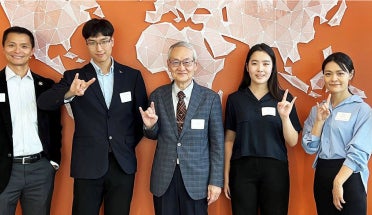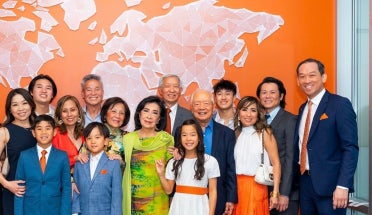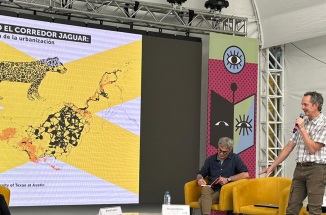
Longhorns at FILUNI Address Environmental, Journalistic, Architectural Possibilities
- Sep 29, 2023
- Global Alumni Relations
- by Alex Briseño
Editor’s Note: This story is part of Texas Global’s series on The University of Texas at Austin’s leadership and activities at FILUNI 2023, a multinational book festival and conference that took place Aug. 29-Sept. 3 in Mexico City. The largest international Longhorn delegation in history — more than 140 people representing 23 units — traveled to the event, which attracted 42,000 attendees from 11 countries.
Set in Mexico City on the campus of longtime UT Austin partner Universidad Nacional Autónoma de México (UNAM), FILUNI’s 84 bookstands and throngs of browsing readers provided an inspiring setting for conference presenters to share groundbreaking research, address global challenges and collaborate with institutions around the world.
Faculty, researchers and performers from the Forty Acres presented 54 sessions and events, including 18 society and technology discussions on topics ranging from artificial intelligence and architecture to media security and global conservation efforts.
Benjamin Ibarra-Sevilla, associate professor of architecture and historic preservation at UT Austin, and Sergio Alcocer, research professor at UNAM’s Institute of Engineering, are just two prominent presenters who exemplified the strong ties between these institutions.
Before Ibarra-Sevilla arrived at UT Austin, he earned his professional degree in architecture from UNAM, while Alcocer took his career to UNAM after earning a Ph.D. from UT Austin's Cockrell School of Engineering. The two led a session with UNAM collaborators about the relevance of science, engineering and architecture, as those disciplines relate to earthquakes in Mexico and the disastrous effects they have imposed around the country.

To forestall further cataclysmic damage in densely populated regions in Mexico, speakers discussed the need to increase the seismic resilience of communities and develop public policies for prevention and restoration. In establishing a dialogue between the fields of applied sciences, natural sciences, social sciences and the humanities, the panel aimed to identify areas of collaboration between UT Austin and institutions in Mexico to garner greater economic and social attention for the effects and mitigation of seismic phenomena across the region.
“I am beyond happy, not only because I am part of the UT Austin delegation, but also because I am an UNAM alumnus,” Ibarra-Sevilla said. “Seeing this point of convergence, seeing how these two institutions are working together toward cooperation, integration and this exchange of knowledge, it’s just fantastic. I’m thrilled about this.”
Juana Salcedo, assistant professor of practice in the School of Architecture, led a captivating roundtable discussion with UNAM colleagues in a session titled “Mapping the Jaguar Corridor: An X-Ray of Urbanization.” The panel identified the correlation between the phenomenon of urbanization and the ensuing socio-environmental struggles facing conservation efforts of the jaguar.
After exploring the urban origins of the environmental crisis and resulting loss of biodiversity, the panel emphasized that a sense of urgency is needed for reimagining new landscapes to combat the jaguar’s shrinking habitat. The Jaguar Corridor Initiative, an unprecedented hemispheric integration project, proposes a series of continuous landscapes that connect the north of Argentina to the southern United States to ensure the survival of the largest feline in the Americas.
A distinguished panel of journalism professionals and researchers joined together to discuss potential methods to improve the conditions and support for media workers in Mexico and Latin America, one of the most dangerous regions in the world for journalists.
The session, titled “Supporting Resilience and Diversity in the Media in Latin America,” featured Rosental Alves, founder of the Knight Center for Journalism in the Americas and professor of journalism and media; Celeste González de Bustamante, associate dean for Diversity, Equity, and Inclusion in the Moody College of Communication who holds the Mary Gibbs Jones Centennial Chair in the School of Journalism and Media; and Liliana Valenzuela, online content coordinator at the Knight Center and editor of the LatAm Journalism Review.
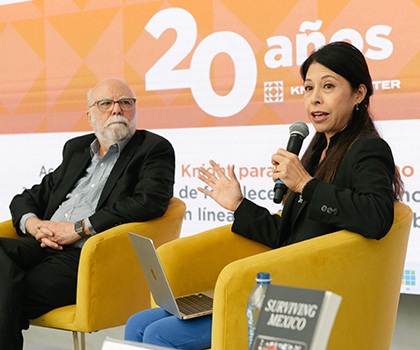
“I was pleased to be part of the largest contingent of UT Austin faculty, staff and students ever to travel abroad together," said Gonzalez. "As someone who has a longstanding relationship with academics in various parts of Mexico, I hope that UT’s participation in FILUNI will inspire even deeper and broader collaborations across both universities.”
From the School of Architecture, assistant professor Ria Bravo, associate professor Kory Bieg and associate professor Clay Odom led a timely discussion on the relationship between artificial intelligence and architecture. The panel took a deep dive into the potential benefits of utilizing AI algorithms in the design process as well as the ethical and philosophical implications that could come with relying on them.
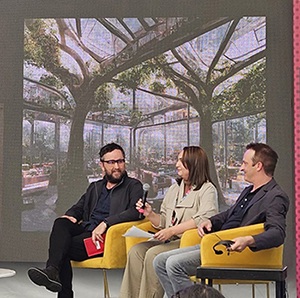
“It was definitely the intention,” said Bravo of the "Artificial Architecture" discussion, which included faculty from the UNAM College of Architecture. “The whole idea [for the session] was based on a conversation between the two universities, trying to plant a seed that could potentially grow into other things. We're going to be meeting one-on-one with UNAM faculty after this, and we'll keep in touch and keep the conversation going.”

